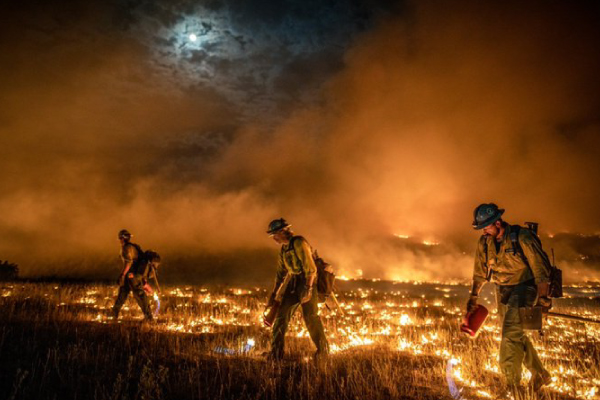 If you live in the valley or have traveled recently in the area, you have probably noticed the abundance of smoke and haziness from nearby fires. You may ask yourself, “Why do we have such frequent fires? How does this impact our community? How can I help?”. If you have found yourself curious about the implications of these recurring fires and what this means to you, your community, and environment, we are here today to help.
If you live in the valley or have traveled recently in the area, you have probably noticed the abundance of smoke and haziness from nearby fires. You may ask yourself, “Why do we have such frequent fires? How does this impact our community? How can I help?”. If you have found yourself curious about the implications of these recurring fires and what this means to you, your community, and environment, we are here today to help.
First, let’s go over a few things, including:
1) Climate change’s impact on fires
2) Consequences of fires on our environment and community
3) What you can do to mitigate your impact on fires
- Climate Change and Fires
Our planet's average surface temperature has risen ~2.12 degrees Fahrenheit since the late 19th century due to human activity. As large corporations and societal structures rely on fossil fuels, the accumulation of carbon emissions changes the environmental function of local ecosystems. Here in Colorado, climate change intensifies the drying of forests with prolonged droughts, reinforces the spread of fire-susceptible evader species (ex: mountain pine beetle), and increases the amount of lightning strikes associated with amplified weather events.
Together, these contributing factors are the perfect recipe for increasing the severity and frequency of wildfires. In fact, the number of large fires has doubled from 1984 to 2015 in the Western United States. Projections from the United States Department of Agriculture (USDA) show that an average annual 1 degree Celsius temperature increase would increase the median burned area per year by as much as 600 percent in some types of forests. Keeping in mind that 80 percent of U.S. wildfires start due to human activity, the warmer temperatures and drier conditions caused by climate change can help fires spread and make them harder to put out.
- Fires and their Environmental and Social Impact
Wildfires play an important role in naturally stabilizing local environments. However, the increase in frequency and caliber of recent wildfires can have detrimental effects on our environment and community.
From an environmental standpoint, an increase in wildfires can decrease soil health, displace thriving habitats and niches, diminish forest fire resilience, and weaken biome regeneration. As wildfires become more and more frequent in the valley, these negative impacts cultivate an environment for fires to occur more regularly and at a larger scale. Solutions focused on mitigating the damages of fires and increasing climate resilience are crucial for minimizing the impacts of wildfires.
On top of environmental externalities, our community continues to face the countless negative health and economic effects of climate change-induced wildfires. The Environmental Protection Agency states that exposure to small particulates from wildfires can increase cases in reduced lung function, bronchitis, exacerbation of asthma, and premature death. Even beyond the given physical side effects, the psychological recovery following the loss of loved ones, homes, livestock, and pets from wildfires is evidently a tough mental challenge for many residents. Patricia Watson, a psychologist at the National Center for Post-Traumatic Stress Disorder, estimates that 10 to 30 percent of wildfire survivors develop diagnosable mental-health conditions, including PTSD and depression. As we face more and more wildfires, we must prepare for the collection of health impacts associated with wildfires to minimize the ramifications of wildfires.
- How YOU Can Prevent Fires

Sometimes it is easy to feel small when facing large complicated systemic issues like climate change and wildfires, we get it! For that reason, we’ve put together 3 easy, productive tips to help you make a difference in preventing wildfires in your community.
- Douse your campfire until cold rather than assuming it’s completely out by splashing a little water on it and calling it a day.
- Check local restrictions before getting involved in any fire-related activities.
- Keep yourself up-to-date with local climate information and issues in your community.
Sources:
- https://journals.sagepub.com/doi/abs/10.1177/2053019616688022
- https://19january2017snapshot.epa.gov/climate-impacts/climate-impacts-ecosystems_.html
- https://www.c2es.org/content/drought-and-climate-change/
- https://fireecology.springeropen.com/articles/10.1186/s42408-019-0062-8
- https://www.jstor.org/stable/10.1086/665007?seq=1#metadata_info_tab_contents
- https://www.scientificamerican.com/article/lightning-may-increase-with-global-warming/
- https://www.c2es.org/content/wildfires-and-climate-change/
- https://science2017.globalchange.gov/chapter/8/
- https://www.fs.fed.us/pnw/pubs/pnw_gtr870/pnw_gtr870.pdf
- https://www.smithsonianmag.com/smart-news/study-shows-84-wildfires-caused-humans-180962315/
- https://www.fs.usda.gov/pnw/page/fire-effects-environment#:~:text=It%20plays%20a%20key%20role,greenhouse%20gas%E2%80%94into%20the%20atmosphere.
- https://fireecology.springeropen.com/articles/10.1186/s42408-019-0062-8
- https://www.nationalgeographic.com/science/article/climate-change-increases-risk-fires-western-us
- https://www.epa.gov/air-research/wildland-fire-research-health-effects-research
- https://www.theatlantic.com/health/archive/2020/07/mental-health-aftermath-california-wildfires/608656
Amelia Kovacs, Sustainability Intern for Walking Mountains Science Center in Avon, Colorado.







